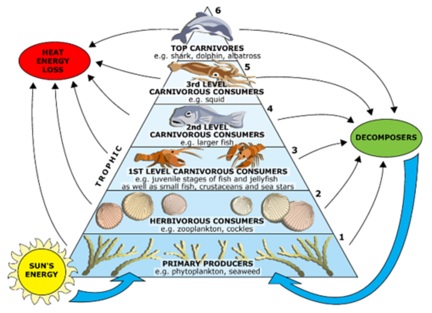Food webs play a central role in depicting feeding relationships and energy flows in an ecosystem. Food webs display the linkages between all organisms within a community and thus, can become rather complex, especially if there are a large number of organisms involved.
When analyzing a food web, the organisms depicted on the bottom represent the producers and the organisms at the very top represent the top predators. The in-between levels are filled with all of the consumers within the community, starting with the primary consumers, then secondary consumers and so on. Some food webs also include the decomposers, although the placement of these organisms varies. In some cases the decomposers are placed under the primary producers and in other instances along the side of the food diagram. Nevertheless, arrows are utilized to depict the flow of energy to and from the decomposers. The figure below provides an example of a food web.1

Figure 1.
Each separate level within a food web is referred to as a trophic level. Therefore, the schematic diagram in Figure 1 represents a food web with 6 trophic levels. As can be seen from Figure 1 there is an energy gain and loss at every trophic level. All of the consumers feed upon the levels directly below them. So for example, the herbivorous consumers feed upon the primary producers, similar to how the 1st level carnivorous consumers feed upon the herbivorous consumers. Additionally, it is noticeable from Figure 1 that there are fewer organisms in each subsequent trophic level as you move upwards.
Furthermore, food webs are also useful when trying to understand the movement of toxins. Toxins of low biodegradability can bioaccumulate up the trophic levels in a food web, with the highest levels affecting the top predators. Evidently, food webs are useful for depicting relationships between organisms and understanding ecosystem stability.
References:
1. thebiosphere1. (2014). Energy Flow in Ecosystems: Food Chains and Food Webs. Retrieved from: http://thebiosphere1.wikispaces.com/Energy+Flow+in+Ecosystems
© BrainMass Inc. brainmass.com July 26, 2024, 7:53 pm ad1c9bdddf